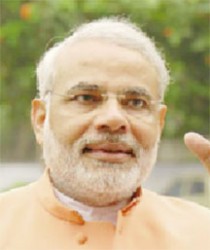KHANNA/KAMARGAON, India, (Reuters) – Just one year after taking office, Indian Prime Minister Narendra Modi is facing a challenge that could come to haunt him – the farm sector that sustains three-fifths of the population is in deep trouble, and he is being blamed for not doing enough.

Promising good governance and a stronger economy, Modi romped to power in elections last May by the biggest margin any Indian prime minister has got in three decades. But the rural crisis has dented his popularity and the vanquished opposition is finding new vigour in his discomfort.
From the start of the crop season last October through March, India’s farm exports have fallen more than 11 percent to $15 billion, as the impact of the global commodities glut has been sharpened by events like Iran’s nuclear talks and a currency dip in Brazil.
The fall in exports has depressed domestic farmgate prices just as unseasonal rain damaged winter crops such as wheat, potato, chickpea and rapeseed. Farmers have little money now to buy seeds for the summer sowing, and meteorologists have predicted the annual June-October monsoon will be below par, which means the next crop may also fail.
“A perception is gaining ground that the government is slow in responding to the crisis in the countryside,” said D.H. Pai Panandiker, president of the RPG Foundation think-tank in New Delhi. “Any inept handling of the situation will only invite trouble and impair the plans for economic reforms.”
Farming accounts for only 15 percent of India’s $2 trillion economy but provides a livelihood to 60 percent of its 1.25 billion people. A crisis in the countryside would have severe political impact.
The opposition Congress party, crushed by Modi a year ago, is latching on to rising discontent in the countryside.
Party leader Rahul Gandhi has been touring the affected farming regions and the heir apparent to the Nehru-Gandhi political dynasty is getting a good response.
“While Modi has failed to help us, Rahul Gandhi was here to assuage our pain,” said Paramdeep Singh, a wheat farmer at Khanna wholesale market in the northern Indian state of Punjab.
“His visit has forced the government to at least acknowledge the fact that we’ve suffered huge losses.”
The fightback by the opposition has slowed Modi’s reform agenda in parliament. This week, Congress delayed bills that would make it easier for corporations to buy land – changes it says are “anti-farmer” – and harmonise national and state taxes.
DRAW THE STING
Finance Minister Arun Jaitley said last week agriculture was the biggest challenge for India’s economy and would need major investments.
Meanwhile, Modi’s government has asked state governments to tap into more than $1 billion from the State Disaster Response Fund and raised compensation by 50 percent for farmers suffering crop losses.
In an attempt to draw the sting of falling exports and prices, the government has also eased quality requirements for wheat purchases by state agencies, raised import taxes on rubber and sugar, and given an incentive for raw sugar exports.
To some farmers, the response is too little, too late.
“When you lose 10,000 rupees ($156), they offer you 100 rupees. So far we haven’t got any assistance,” said Manik Andhale, a farmer from Kamargaon village in Maharashtra state, whose onion crop suffered rain damage.
To be sure, some of the events that have led to the crisis are beyond the government’s control.








